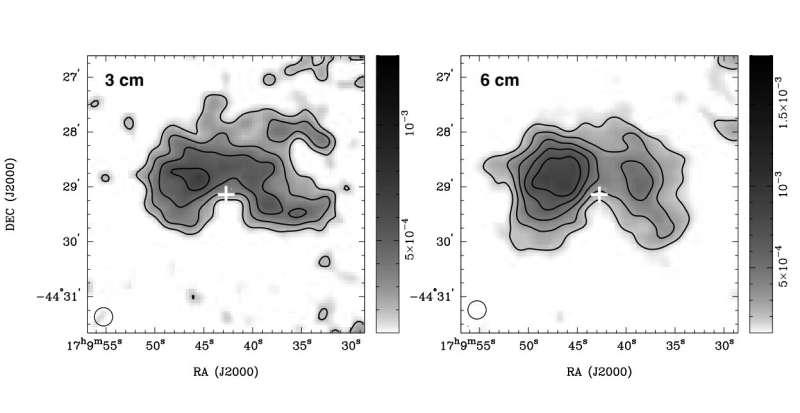February 8, 2023 report
This article has been reviewed according to Science X's editorial process and policies. Editors have highlighted the following attributes while ensuring the content's credibility:
fact-checked
preprint
trusted source
proofread
Researchers inspect a nearby pulsar wind nebula

Using the Australia Telescope Compact Array (ATCA), astronomers from Hong Kong and Australia have performed radio observations of a nearby pulsar wind nebula (PWN) powered by the pulsar PSR B1706−44. Results of the study, published January 31 on the arXiv pre-print server, deliver important insights regarding the properties of this PWN and its associated pulsar.
Pulsars are highly magnetized, rotating neutron stars born supernova (SN) explosions, emitting a beam of electromagnetic radiation. They are usually detected in the form of short bursts of radio emission; however, some of them are also observed via optical, X-ray and gamma-ray telescopes.
PWNe are nebulae powered by the wind of a pulsar. Pulsar wind is composed of charged particles and when it collides with the pulsar's surroundings, in particular with the slowly expanding supernova ejecta, it develops a PWN. Observations of PWNe have shown that the particles in these objects lose their energy to radiation and become less energetic with distance from the central pulsar.
At a distance of some 8,500 light years from the Earth, the B1706 PWN is a pulsar wind nebula with a compact torus and jet structure, powered by the Vela-like pulsar PSR B1706−44. The PWN showcases a diffused emission around the torus and has a long curved outer-jet. The pulsar, moving eastward with a projected velocity of 130 km/s, has a characteristic age of 17,100 years and a spin-down power of about 4.0 erg/s.
PSR B1706−44 is located at the east-west ridge of the southern part of a supernova remnant (SNR) known as G343.1−2.3. Previous studies suggested that PSR B1706−44 is associated with this SNR, finding an extended TeV emission west of the pulsar, which has some connection with the remnant.
A team of astronomers led by Yihan Liu of the University of Hong Kong has conducted high-resolution radio observations of B1706 PWN in order learn more about its properties, which could also shed more light on the potential connection of the pulsar with G343.1−2.3.
"In this paper, we analyze new and archival radio observations of the PWN powered by PSR B1706−44 (hereafter B1706 PWN) and SNR G343.1−2.3 taken with the Australia Telescope Compact Array (ATCA) at 3, 6, 13, and 21 cm images. We employed new observations with high resolution aiming to better study the morphology and polarization information of this PWN," the researchers explained.
The radio observations found that B1706 PWN exhibits an overall arc-like morphology at 3 and 6 cm, and that this "arc" shows two distinct peaks at 6 cm. The arc-like structure has dimensions of 4 by 2 arcminutes and wraps around PSR B1706−44 in the north.
According to the study, no radio emission was detected at the PWN's X-ray torus and jet location, but was identified only beyond 10 arcseconds from the pulsar. The astronomers assume that the radio PWN morphology can be fit by a thick torus model with Doppler boosting effect. They noted that this would mean a bulk flow velocity at a level of about 20% the speed of light, therefore lower than that in the X-ray torus.
The study found that B1706 PWN has a toroidal magnetic field with a field strength of about 10 µG—assuming equipartition between particle and magnetic field energies. This suggests a slight decay compared with that of the X-ray bright region.
The observations also found that the ridge of G343.1−2.3 exhibits elongation and magnetic field well aligned with the proper motion direction of PSR B1706−44, as well as a radio spectrum flatter than the rest of the shell. The researchers concluded that these results may indicate that the ridge is a pulsar tail instead of being a filamentary structure of the SNR.
More information: Y. H. Liu et al, Radio Study of the Pulsar Wind Nebula Powered by PSR B1706-44, arXiv (2023). DOI: 10.48550/arxiv.2301.13651
Journal information: arXiv
© 2023 Science X Network





















